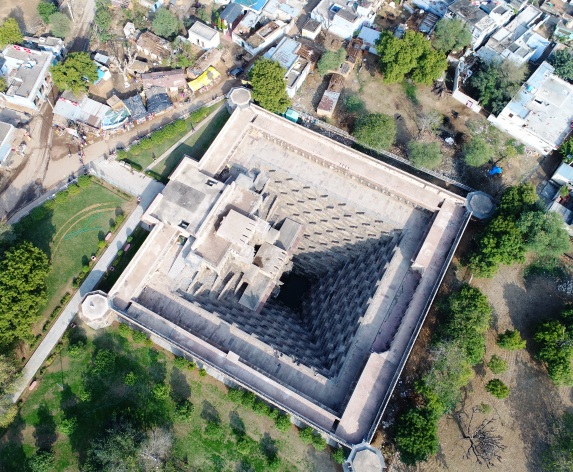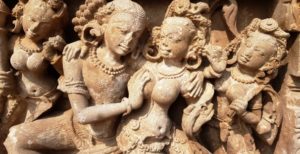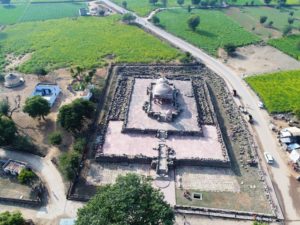Photographs taken to bring tourists. And photographs taken by tourists themselves. Some minor details are always missing between these two. In my case it was a long line of big-boned women clad in ghaghra, choli and odhni or the veil, balancing earthen water pots on arcing hips tracing a colourful line like the Madhubani-painted Bihar Sampark Kranti Express pootling along the platform. I saw this in some tourism literature while attending the Jaipur Literature Festival and was instantly enamoured – equally by the women as by the setting. Coy heads bent from a distance, they were inside what looked like a stepped subterranean amphitheatre of semi-cathedral dimensions. It was the ancient Chand Baori, stepwell, of Abhaneri 93 km from Jaipur along the Jaipur-Agra highway.
A gaggle of Korean visitors crossed my path as I drove into the village. Many I recognised from the festival – tripping over trailing pallus of saris that refused to remain tucked inside leggings. English and Australian groups traipsed around in pairs; young couples first rummaged each other and then delivered lingering kisses. Fruit and bric-a-brac vendors kept largely silent probably confused at which language to announce their wares. Vehicles were parked along the dusty main drag where I parked mine expecting someone in a cholera-yellow vest with ‘MCD’ on it to pounce on me with little black handheld devices that whirred out parking tickets. None did. The stepwell itself was hidden from view as it is within an enclosure surrounded by a park flanking the road. But the other major Abhaneri attraction, the Harshat Mata temple with its perfect dome atop the pillared mandapa, the main hall, stood facing the rising sun.
‘Abhaneri’ came from ‘Abha Nagri’ or ‘city of light.’ If it was in the literal sense then the whole of Rajasthan should have been called just that. Probably this is where the Harshat Mata comes in. ‘Harshat Mata’ means the ‘mother of joy.’ Built by King Chand who ruled Abhaneri during 8 – 9th centuries, local lore goes that anyone who enters the temple will be blessed with happiness. Besides the lure of comely ladies fetching water I confess this too was a reason for me to undertake the trip.
The temple of joy and some misguided history
Fine carvings in stone, definitely those from a millennium ago, are in themselves ataraxic: you just have to close your eyes and see their makers grind away patiently, lovingly, hypnotically, with adzes, chisels and mallets. Intricate etchings on the plinths, deities and scenes from everyday living are carved on the niches of the upper platforms and buttresses. A man, decked out in chunky jewellery, has his right hand clasped firmly around the breast of a woman whose arm is entwined around him. Other women, ostensibly participants in the royal orgy, look on excited and demure. Testimonies in stone to a past that was so liberated sexually from which arose the wondrous heritages of Khajuraho and Konark, Lingaraj or the virtually unknown Bhoramdeo in Chhattisgarh.
Walking towards the open sanctum, I saw the temple priest in saffron robe and white flowing beard applying kunkum on the foreheads of tourists with an indulgent smile. The tourists themselves took it as titivations and turned around immediately to capture the red in a bright selfie. I waited around for some quiet time with the priest: I wanted to ask him about the columns – or parts of it – strewn on one side of the temple. There were ornate bases and capitals with floral designs, gargoyles and other mythical monsters and celestial beings.
“Oh, those?” He asked, waving his hands indignantly, “They are from the destruction left behind by Muslim rulers. Mahmud (of) Ghazni is to be blamed for most of it.” He then asked me if I have heard of Ghazni.
The Afghan invader/plunderer, from around the same timelines the temple was built, did unleash havoc on the Indian subcontinent a record 17 times. He did ride roughshod over several temples as well. But if he did come across this one, why the selective destruction? Sparing of the sanctum and the fabulous colonnade that lead to it? It wasn’t exactly like the Chiu Gompa in Tibet – looking at which itself would have tired out the Red soldiers of the Cultural Revolution. As temple priests, like religious heads anywhere, are not exactly known to be woke, I didn’t ask him but left it to the narrative that has found favour with the times.
Dirty droning over the stepwell
Scholars maintain that the temple came nowhere near the path taken by Mahmud of Ghazni in his coffer-filling forays into India. While history gets twisted into agenda-bound word salads at the hands of our cultural ambassadors who are points of first contact, documenting the present is made difficult by the rest – the foot soldiers of different state departments. While I was flying my drone over Abhaneri, some men claiming to be from the local Archaeological Survey of India office tried to stop me saying I needed to procure the necessary permits from their boss. I tried to explain to them that my drone came in the micro category weighing less than 2 kg, was over 5 km away from the nearest airport and was flying under 60 metres. Still they insisted I secure permission. But from whom they had the faintest idea.
However, these eager beavers are not to be blamed. The recent press over dilly-dallying drone regulations has everyone thinking that anyone with a drone camera is a threat to national security. While the ambiguities over NTPT-compliances and UIN continue, everybody remains clueless about what to do with market leaders DJI and Parrot whose products have already flooded the market, whose manufacturers are yet to be a part of any policy-level meeting. As Mark Tully rightly points out, in India the government is more often the problem than the solution.
From the air the stepwell looked like an inverted chessboard, a geometric marvel. The emerald-green water at the bottom along with the village belles were missing. Aria, a local I met later, informed me that only during the peak of monsoon months does the baori get any water. Harsh fencing kept people from venturing inside. Also built by King Chand who built the temple, this is the largest and deepest stepwell in India with 3,500 narrow steps going down nearly 20 metres. Aria told me the narrow steps were a safety feature as it ensured you didn’t climb down straight but sideways – giving you a better foothold. The double flights of steps are criss-crossing and cut into three sides of the well and descent in a tapering fashion. On the fourth side are exquisitely carved jharokhas, or hanging balconies, spread across three storeys. Adorning the supporting pillars are idols and dainty sculptures the details of which are visible only with a good zoom.
“But why is the whole well cordoned off?” I asked the bunch of loungers – whom you find in every ASI monument, whose job is uniformly to tell you that video cameras have a higher ticket rate. These guys, it seems, believe that motion photography can be done only with devices sprouting viewfinders.
They replied I had to ask their boss. But didn’t tell me where to find this elusive one.
For my new friend, the all-knowing Aria, I had a question: Once you shower in the baori below and by the time you reach back to ground zero, wouldn’t it be time for another shower?
“Who said people went in only to bathe?” Aria asked, seriously. “After a hot day out in the fields, many would go down to just sit in the cooler confines.” The deeper recesses of the well, I read later, were 5 – 6 degrees cooler than outside throughout the day.
I wondered if a photograph of women cooling off, even in their colourful attires, would have made me undertake the 93 km journey.


















thanks for giving such type of photographs
Highly informative article about the archaeological sites along with photographs is rare. Rajasthan is not just forts and palaces but, such marvels too! Thanks for such a great post. Keep it up!
This looks dangerous when i saw the picture of this first article. Impressed of architecture.
hello dear, Konark temple Khajuraho temple and there site sene is very very awesome.
thanks for giving such type of photographs
The Top Ten Most Beautiful Countries in The World 2019
Great articles
I am planning to visit Rajasthan with my family, Have you have any articles related tips for Rajasthan
Great job!!!!
this article. is exlant . nice photographs type of this article . thanks for sharing such valuable information
Find More on http://ecgnews.org
Thanks for this article. I’m hoping to go to Rajasthan later this year and this is one of the first stories I read that shares more about what it feels like to be there than just stopping at some major sites.
Thank you. Yes, later in the year is a good time to be there.
thanks for giving such type of photographs
Photographs are great. Content is great too, it has increased my anxiety to visit Rajasthan.
Thanks for sharing
oh my god, it was so beautiful, I hope someday I can take a vacation there, thanks for sharing
its a amazing,
very beautiful to visit
Thanks For sharing…
I am planning to visit Rajasthan with my family, Have you have any articles related tips for Rajasthan
Great Article …
There are quite a few. Please search Rajasthan on my blog. Safe journey.
i am planning to visit this September this year. is it correct time or do i plan in November due to hot atmosphere.
Nov to Feb is a better time.